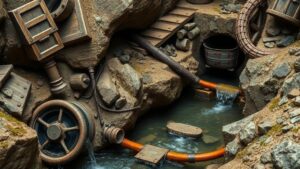Identifying Natural Potholes as Effective Gold Traps
Identifying Natural Potholes as Effective Gold Traps
The quest for gold has captivated humanity for centuries, leading to extensive exploration and mining activities across the globe. One of the lesser-known yet highly effective natural phenomena in gold prospecting is the presence of potholes. This article delves into how these geological formations can serve as effective traps for gold and provides insight into identifying them in various environments.
Understanding Potholes
Potholes, in the context of geology, refer to depressions or cavities that can form in riverbeds or stream channels as a result of erosional processes. are typically caused by the combined effects of water flow and sediment movement, often exacerbated by elements such as ice and rocks. The significance of potholes in gold trapping lies in their ability to alter water flow and create sedimentary deposits.
The Mechanism of Gold Trapping
Gold is substantially heavier than many other materials present in river systems. When water flows over varying terrain, including the dips created by potholes, it slows down, allowing heavier particles, such as gold, to settle.
- The turbulence created by the water flowing into and out of a pothole can be conducive to the deposition of heavy materials.
- Gold particles get trapped within these depressions, often alongside other heavy minerals like black sand.
Identifying Natural Potholes
Locating natural potholes can significantly enhance the efficiency of gold prospecting efforts. Here are the key indicators to identify these geological formations:
- Shape and Size: Potholes are typically circular or oval in shape and can vary widely in size.
- Water Flow Patterns: Observing how water flows in a stream can provide clues; slowing water typically indicates the presence of deeper areas, including potholes.
- Surrounding Topography: Steep banks or bedrock walls often flank potholes, creating an environment conducive to the accumulation of sediments.
- Presence of Other Deposits: The accumulation of black sand and other heavy minerals in conjunction with potholes indicates effective trapping sites.
Real-World Applications: Case Studies
Historical accounts from gold rushes illustrate the effectiveness of targeting natural potholes in stream and river environments. For example, during the California Gold Rush (1848-1855), miners discovered that areas with significant potholes along the Sierra Nevada foothills yielded substantial gold deposits. More recent studies in Alaska have shown that several active mining operations capitalize on potholes formed by glacial activities, leading to increased gold recovery rates.
Challenges and Considerations
While potholes can be effective gold traps, several challenges must be considered:
- Fluctuating Water Levels: Seasonal changes can dramatically affect the water levels, altering the trapping dynamics and accessibility of potholes.
- Environmental Regulations: Mining in certain areas may be restricted due to conservation efforts, necessitating an understanding of local laws.
Actionable Takeaways
For gold prospectors looking to utilize natural potholes effectively, consider the following steps:
- Study maps and geological surveys to identify potential river systems known for gold deposits.
- Conduct field explorations during low water levels for optimal visibility and access to potholes.
- Use metal detectors to enhance the chances of locating gold in these natural traps.
- Stay informed about local environmental regulations and best practices to minimize impact on ecosystems.
To wrap up, understanding the geological features of natural potholes and their role as effective gold traps can greatly enhance the success of gold prospecting endeavors. By applying this knowledge strategically, prospectors can maximize their yield while maintaining an awareness of environmental stewardship.


